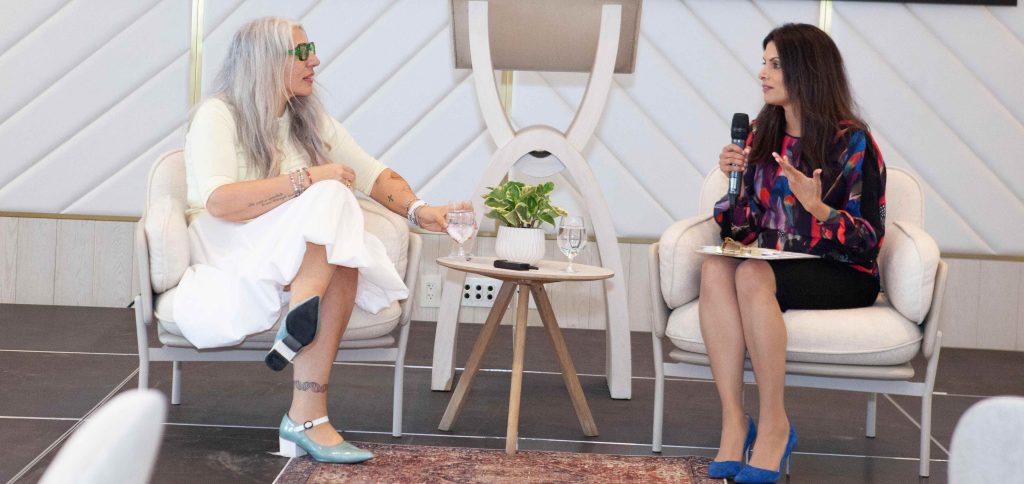The first Women, Health, Innovation Conference brought together women from health and patient care, business, finance and personal care to explore solutions, foster collaboration, and drive change in the health field. Fostering understanding and offering ways to help attendees shape their own health and wellness journeys, that day brought women together and planted the seeds for future innovation.
At our second conference, we are fortunate to welcome back Dr. Zayna Khayat as our featured keynote speaker. She explores potential healthy futures every day as a health futurist. As an Adjunct Professor, Health Sector Strategy, Rotman School of Management, University of Toronto and a Health Futurist in Residence in Deloitte Canada’s Life Sciences & Healthcare practice, she helps people and organizations explore and plan what comes next for healthcare, in a world of rapidly changing technology, and health and societal challenges.
In advance of her keynote talk, Zayna provides some thoughts on what the future of Canadian healthcare could be. Come hear the details at the Women, Health, Innovation Conference: The Future of Healthcare for Women on May 8, 2025 in Burlington, Ontario.
What are the key questions that need answers in healthcare & technology/artificial intelligence today?
We have decades of “technical debt” in healthcare in Canada that we are still paying off, whereas other jurisdictions have paid their debt and can focus on modernizing healthcare with technology and AI. That is, the foundational digital backbone is not yet built, and so we are not able to reap the benefits of all of today’s health technology – especially AI. The key focus area needs to be getting foundational technology and info-structure in place, so we can firstly take a lot of the friction out of the healthcare experience for patients and clinicians today. Secondly, we need to start to accrue the benefits of emerging technology on 5 key areas: better clinical outcomes, lower cost of care, better patient experience, better staff experience, and more equitable outcomes for patients.

For women especially, this is a profound shift, as we move from ‘intervention-based’ medicine to ‘intelligence-based’ medicine. In this future, decisions are made using data and information from multiple sources, well beyond what is in a traditional medical chart. The power of near real-time data and insights that are multi-modal is immense. We are approaching the ability to practice truly n-of-1 medicine and healthcare that is individualized, tailored and highly configurable to each woman’s unique biology, preferences, needs, expectations and health literacy level.
What is your 2025 outlook? What are you looking most excited about in 2025?
For 2025, I am most excited about the many use cases for AI being implemented and gaining traction in both the operational/administrative and the clinical/care delivery realms.
Given the massive gaps in women’s health across the entire value chain from research and development through to care delivery, the potential to benefit from AI is huge. Every aspect of women’s health is up for grabs to be reimagined with these new AI tools, which are getting better, smarter, faster and cheaper by the hour. For example, in fertility, AI is being used by Canadian company Future Fertility to overcome a major bottleneck to successful in vitro fertilization – smarter selection of eggs to create embryos more likely to be viable.
If you had a magic wand, what would you like to see change in Canadian health care?
Democratization. I would like to see the labour structure of healthcare delivery fundamentally changed. More than 80% of the $360B we spend in Canada in healthcare (11% to 12% of our GDP!) is labour. The labour is fixed in supply, and the money to pay for the labour is also constrained (as most of it is financed through taxation, which is not growing nearly as fast as demand for care is growing). The promise of technology adoption plus policy innovation around scope of practice and care models is the pathway to this vision. It will ensure the right and least costly humans are there for people who need human care. That way that everyone who needs care can get it when and where they need it.
As well, the evidence is clear about what causes disease in women, and what interventions can help maintain or restore health. Yet, many proven interventions are not yet reimbursed by public health insurance schemes. For example, menopause care and associated treatments don’t have a fee code for a family medicine provider, yet half the adult population is in – or will enter – this stage of life and be alive longer in menopause than not in menopause.
Join us at the Women, Health, Innovation Conference: The Future of Healthcare for Women on May 8, 2025 at The Pearl Hotel in Burlington, Ontario.
Author: Seanna-Lin Brodie-Keys

